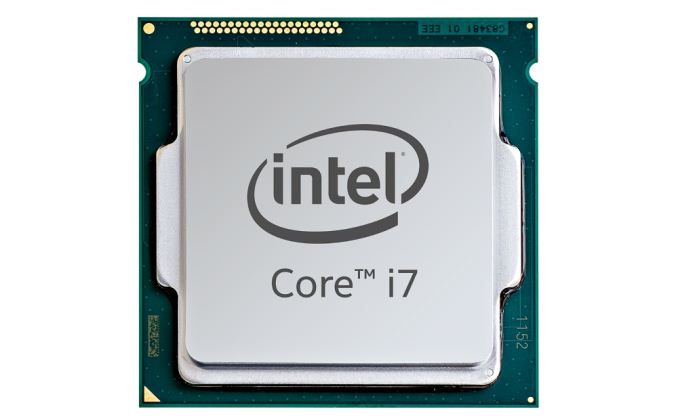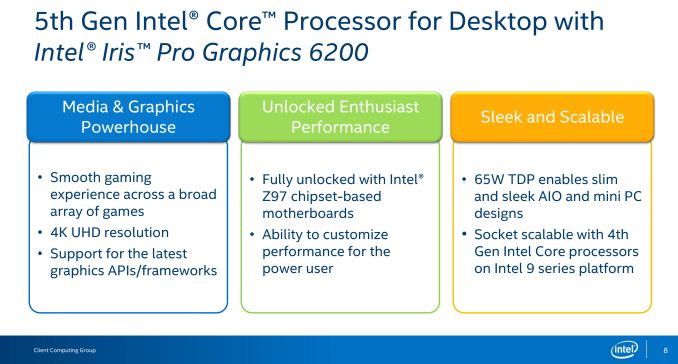The Intel Broadwell Desktop Review: Core i7-5775C and Core i5-5675C Tested (Part 1)
by Ian Cutress on June 2, 2015 7:45 AM ESTBroadwell-DT: Initial Thoughts
The new Broadwell desktop processors are somewhat out of sync with our regular expectations from Intel. Due to issues surrounding the 14nm node, as well as the cost, the whole Broadwell line from tablet to table-top has come out slower and more staggered than any Intel release in recent memory. As a result, the initial launch from Intel today is a pair of 65W desktop socketed models backed up with three 65W soldered down models whose true heritage is a chip primarily designed for large laptops and all-in-one devices.
Normally we would expect a range of desktop models from 35W up to 88W or higher, but socketed Broadwell-DT today only exhibits two units at 65W. This immediately puts a slight damper on those expecting to upgrade from Haswell’s high-end, or those wanting to go from something like a Pentium G3258 on Haswell to Broadwell’s top SKU. As a result, we have to keep our expectations in check – 65W should on paper perform nearly as well as an 88W part would, except it would be reduced by several hundred MHz. Meanwhile as these processors are also fully-unlocked and overclockable, we're left to ponder whether or not the stock frequencies actually matter in that case.
Due to the differential tangent at play, these processors also exhibit Intel’s best integrated graphics package, Iris Pro (GT3e), previously reserved only for soldered down/laptop/mini-PC orientations. This graphics package comes with largest number of execution units available from Intel, 48, alongside 128MB of eDRAM that acts almost like an L4 cache. This helps alleviate memory bandwidth pressure by providing a large(ish) pool near the CPU but with lower latency and much greater bandwidth than main memory. The eDRAM has the greatest effect in graphics, but we also saw some moderate increases in our non-3D regular benchmark suite.
The benefit of the graphics package, Iris Pro 6200, means that Broadwell-DT takes the crown as the fastest socketed graphics available. Our testing showed that the even the second-tier socketed SKU, the i5-5675C, outgunned the previous title holder, AMD’s A10-7870K. Despite having the i7-5775C in to test, due to time and firmware issues, we were unable to run the numbers on the integrated graphics but will do so in a later piece.
The key element to Broadwell-DT is not to consider it a natural successor to Haswell. It doesn't so much replace Haswell-K at this time, so much as it occupies a space Intel has left neglected since the launch of Haswell – the ultimate Intel integrated graphics solution. For users on integrated graphics, where money is no object, Intel now offers you the option to combine the regular CPU performance associated with Intel and a GPU that has the added performance benefits of on-chip, high-bandwidth eDRAM. The only question is whether that combined performance is worth the potential cost, and some would say no, pointing at a combined APU + GPU solution for equivalent or better gaming performance for the same price.
Pricing for the i5-5675C is listed as $276, slightly higher than the price of the i5-4690K which is at $236 on Amazon (reduced from $265). The i7-5775C is a bit higher at $366, also a margin higher than the i7-4790K which is $339 (reduced from $380). This makes Broadwell a tough sell right now in most circumstances unless you are absolutely limited to integrated graphics and want the best solution possible in a configurable PC. Given that Intel has also mentioned Skylake in their recent Computex keynote, it implements an abnormal situation that Intel has never been in with a new platform being talked about in the same breath. We have been told that these parts exist because users wanted them, and it has been interesting to see just how the added eDRAM changes the performance with discrete graphics in the mix.












196 Comments
View All Comments
nandnandnand - Tuesday, June 2, 2015 - link
A10-7870K is listed as $137 and A10-7850K as $173Ian Cutress - Tuesday, June 2, 2015 - link
$137 is the launch price of the A10-7870K.$173 was the launch price of the A10-7850K.
We mentioned why we do launch pricing in our graphs in previous reviews, but it comes down to our graphs not being dynamically linked to a retailer and we have to pick a point that's suitable over time. Launch pricing does that, even though there might be future discounts over time.
nandnandnand - Tuesday, June 2, 2015 - link
Ok, that makes sense.Business opportunity: add a drop down to switch from launch price to "live price" for Newegg/Amazon/etc., hyperlink live prices, get a cut from every click.
AS118 - Saturday, June 6, 2015 - link
I agree with nand. Other sites do this, and it's helpful to me because I often read reviews to make a purchase anyway, and it helps me see what the price is right now.FlushedBubblyJock - Sunday, June 14, 2015 - link
Take a look at how much the GTX980 stomps the amd 290X above - in the review here where they aren't concerned and paying attention and picking the best games for amd gimpy hardware.Just look at the FPS difference... let it sin in - the reviewers haphazardly reveal the truth when they are not intending to.
bloodroses75 - Wednesday, June 17, 2015 - link
Oh look, a current gen video card beat a last gen card that is just over half the price.You may want to try waiting until the 300 series is released/ bench marked before spouting how superior one is over the other. If the 300 series ends up being a dud (which it kinda looks like it will), so be it; at least it will be an 'apple to apple' comparison.
MrSpadge - Tuesday, June 2, 2015 - link
You don't need dynamically updated prices. simply pick the prices around the release date of the new hardware. If the price of a 1 or 2 years old comparison chip was lowered significantly (yes, this still happens sometimes), comparing it based on launch price is misleading and will always make some people shout "unfair". You easily fix this.taltamir - Tuesday, June 9, 2015 - link
I agree, the obvious thing to do is use the price as it is during the time the article was written.That means launch price for the item being reviewed and current prices for all items it is being compared to
ImSpartacus - Tuesday, June 2, 2015 - link
Since you have to do a "snapshot" pricing for these reviews, you may want to consider looking at average pricing at the time of review. At least then the time frame for each snap shot is the same.nathanddrews - Tuesday, June 2, 2015 - link
There's a fine line between "just enough" information and "too much". Prices for CPUs vary greatly depending on where you buy them.